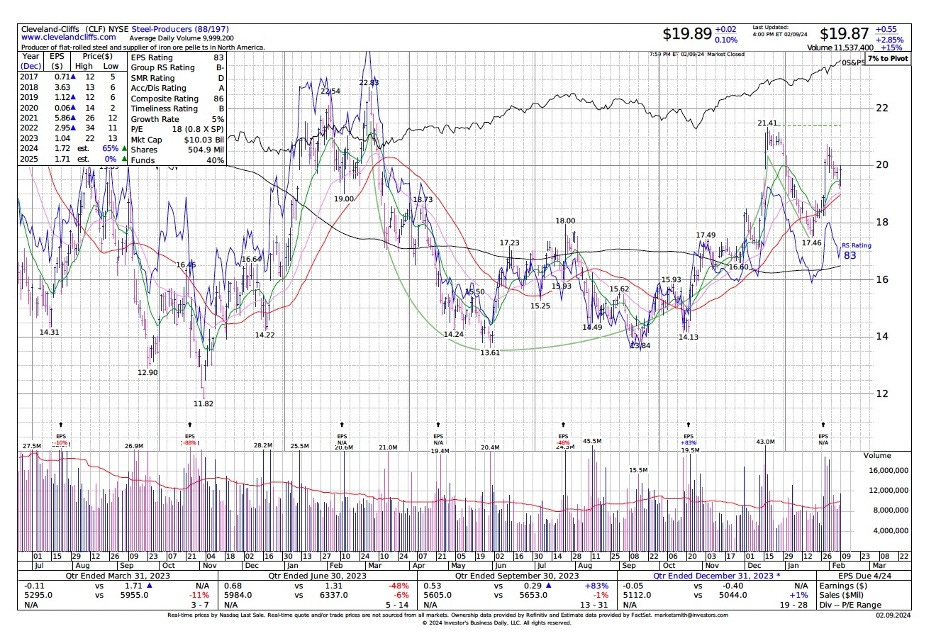Jay Powell on 60 Minutes: U.S. Fiscal Path Unsustainable
CBO Warns 2025 Debt Interest Costs to Exceed World War II Levels
The cost to service the US government’s burgeoning debt load will hit a record high next year and then keep on climbing, according to the Congressional Budget Office. https://www.bloomberg.com/news/articles/2024-02-07/us-debt-set-to-skyrocket-to-record-over-next-decade-cbo-says.
China Deflation Worsens
China's consumer prices fell at their steepest pace in more than 14 years in January while producer prices also dropped, ramping up pressure on policymakers to revive an economy low on confidence. Analysts warn the overall deflationary impulse risks becoming entrenched in consumer behavior. https://www.reuters.com/world/china/chinas-consumer-prices-suffer-steepest-fall-since-2009-deflation-risks-stalk-2024-02-08/.
NYCB Insiders Are Buying Up the Battered Stock
Insiders at New York Community Bancorp bought more than $870,000 of NYCB 0.00%↑ stock on Friday as shares of the regional lender rallied after their recent slump. According to forms filed with the Securities and Exchange Commission. Shares gained about 17% to $4.90 on Friday, but the stock is still down about 53% since Jan. 31 when NYCB disclosed a surprise fourth-quarter loss, and slashed its dividend to bolster capital. The bank cited its acquisition of Signature Bank last year, and losses in commercial-real-estate loans. It also set aside more reserves for potential loan losses. Shares tumbled in response. In the days after, another shoe dropped when NYCB’s debt was downgraded to junk.
• Executive Chairman Alessandro DiNello bought 50,000 NYCB shares for an average price of $4.19 each.
• Director Peter Schoels bought 100,000 NYCB shares for an average price of $4.15 each.
• Lee M. Smith, senior executive vice president and president of mortgage bought 25,000 shares for an average of $4.05 each.
• President and CEO Thomas R. Cangemi bought 11,310 NYCB shares for an average price of $4.41 each.
• Reginald E. Davis, senior executive vice president and president of banking, bought 1,200 shares for an average price of $4.10 each.
• Julie Signorille-Browne, senior executive vice president and chief operating officer bought 2000 shares for an average price of $4.76 each.
• Directors David Treadwell, a former CEO of manufacturer EaglePicher, and Jennifer R. Whip, a principal with Cambridge One, LLC, and a former Fannie Mae executive bought 15,000 and 5,100 NYCB shares respectively, each paying an average price of $4.17 per share.
https://www.barrons.com/articles/nycb-stock-buys-insiders.
So many insider buys at the same time suggests coordination which is not as bullish as more organic activity.
Cleveland-Cliffs’ newest director recently picked up shares of the steel maker. Ron A. Bloom paid $506,100 on Feb. 1 for 25,000 CLF 0.00%↑ shares, at an average price of $20.24 each according to a filing with the Securities and Exchange Commission. https://www.barrons.com/articles/cleveland-cliffs-stock-buy.
This Week in History
In 1968, in what became known as the Orangeburg Massacre, nine South Carolina Highway Patrolmen and one Orangeburg city police officer opened fire on a crowd of African American students, killing three and injuring at least twenty-eight. The shooting of student protesters on the campus of South Carolina State College in Orangeburg, South Carolina were the culmination of a series of protests against racial segregation at a local bowling alley, marking the first instance of police killing student protestors at an American university.
In the summer and fall of 1967, a whites-only bowling alley near campus, All-Star Bowling Lane, became a focus of student protests. Owner Harry K. Floyd repeatedly refused students' requests to desegregate. Instead, he followed the trend of replacing his "Whites Only" sign with one saying "Privately Owned" (saying that only "club members" would be allowed in). In October, the college's NAACP chapter invited a lawyer to discuss how they could mount a legal challenge. The lawyer explained that while the legal status of segregated bowling alleys was unclear, the fact that All-Star had a lunch counter meant that it was required to desegregate under the Civil Rights Act of 1964. Eventually, student activist John Stroman, an avid bowler, decided to prove that Floyd's club-members-only strategy was a cover for refusing black patrons by sending in his friend, SC State’s only white student, to bowl without a club membership. The white student arrived and began bowling without a problem. A little while later, Stroman and a group of black students[d]arrived and asked to bowl. When the staff refused to let them, the students tried sitting at the lunch counter and were refused service there as well.
Harry Floyd, owner of the segregated bowling alley in Orangeburg, S.C., over which civil rights demonstrations ended in the death of three students, points to the "privately owned" sign on the front door, Feb. 10, 1968. AP
On the night of February 8, students started a bonfire at the front of State College's campus. When police moved to put out the fire, students threw debris at them, including a piece of a wooden banister that injured an officer. Several minutes later, at least nine patrolmen and one city police officer opened fire on the crowd of unarmed students. Dozens of fleeing students were wounded; Sam Hammond, Henry Smith, and Delano Middleton were later pronounced dead at the Orangeburg Regional Hospital.
Black students staged demonstrations across the country. Despite the fact that the Orangeburg Massacre was the first time police shot and killed students on a United States university campus, they received much less media coverage than the later police shootings at Kent State and Jackson State.
Federal prosecutors charged nine patrolmen who had admitted to firing on the crowd with deprivation of rights under color of law, but they were acquitted although 36 witnesses stated they did not hear gunfire from the protesters on the campus before the shooting, and no students were found to be carrying guns. The state of South Carolina charged one of the protestors, Cleveland Sellers, with several riot charges. He was convicted on charges relating to events two days before the massacre and sentenced to one year in prison.
Bevahioral Economics Principle of the Day
Decoy Effect: The phenomenon where the introduction of a third, less desirable option influences decision-making by making a previously presented option appear more favorable. It can lead to irrational behavior by manipulating preferences and distorting decision outcomes.












